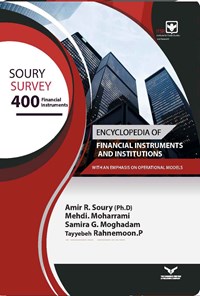
کتاب Encyclopedia of Financial Instruments and Institutions
معرفی کتاب Encyclopedia of Financial Instruments and Institutions
کتاب الکترونیکی «Encyclopedia of Financial Instruments and Institutions» نوشتهٔ امیررضا سوری و مهدی محرمی و سمیرا گلکاران مقدم در انتشارات چاپ و نشر بازرگانی چاپ شده است.
درباره کتاب Encyclopedia of Financial Instruments and Institutions
در این کتاب ابتدا بازارهای مالی، ابزارهای مالی، تنظیم کنندگان مالی، نهادهای مالی، خدمات مالی و بانک مرکزی توضیح داده میشود. سپس انواع طبقهبندی از بازار سرمایه براساس مرحلهٔ انتشار، ساختار و زمان انجام و تحقق معامله، انواع روشهای تأمین مالی از خارج اعم از قرضی و غیرقرضی ارائه میشود. همچنین دربارهٔ گسترهٔ مشارکت بخش خصوصی در پروژههای توسعهای و زیرساختی و همچنین انواع مدلهای تأمین مالی و تحویل پروژهٔ طرحهای تولیدی، زیربنایی، صنعتی و خدماتی، تشریح انواع روشهای نوین تأمین مالی و همچنین روشهای تأمین مالی ساختاریافته شرح داده میشود. در آخر نیز انواع ریسکهای مالی و رابطهٔ ریسک و بازدهی ابزارهای مالی بررسی میشود. عناوینی که کتاب دانشنامهٔ ابزارها و نهادهای مالی: 400 ابزار مالی با تاکید بر مدلهای عملیاتی به آنها میپردازد در یک نگاه به این شرح است:
دستهبندی انواع روش های تأمین مالی
روشهای تأمین مالی از بازار پول
روشهای تأمین مالی بازار سرمایه
روشهای تأمین مالی از خارج
انواع مدلهای تحویل پروژه باتوجهبه مشارکت بخش خصوصی
ابزارهای نوین مالی
انواع ریسک مالی
کتاب Encyclopedia of Financial Instruments and Institutions را به چه کسانی پیشنهاد میکنیم
این کتاب به علاقهمندان به علم اقتصاد و حسابداری و امور مالی پیشنهاد میشود.
بخشی از کتاب Encyclopedia of Financial Instruments and Institutions
«Chapter 1 introduces components of the financial system including financial markets, financial instruments, financial regulators, financial institutions, and financial services. In addition, a systematic framework of the features of the tools is presented, by classifying the types of financing by maturity, ownership, and source of financing. The final part of the chapter also introduces a variety of internal and external financing methods. Second chapter identifies a variety of direct and indirect central bank regulatory tools. Then the types of financial and credit institutions in the world and its structural differences with Iran are explained. The remainder of the chapter is devoted to identifying, classifying and introducing all types of monetary market instruments. Chapter 3 presents the classification of the capital market based on the stage of issuance, structure and time of execution and transaction realization. Then a variety of capital market institutions, including self-regulating institutions, market intermediaries and other market players are introduced as well. Also, various types of capital market instruments including securities, debt securities, hybrid securities, derivative securities as well as Islamic financial instruments have been studied in detail. The end of the chapter also introduces the types of investment funds and their functioning in the financing system. Chapter 4 deals with a variety of external and non-borrowing financing methods. borrowing methods, various types of corporate and project financing methods are also described, and in the section on non-borrowing methods, foreign direct investment, foreign investment in the portfolio of financial assets and bilateral trade are discussed as well. This chapter also describes a variety of international shipment and payment methods. Chapter 5 describes the scope of private sector participation in development of infrastructure projects as well as a variety of financing models and project delivery for manufacturing, industrial and service projects. The final section of this chapter is devoted to describing and comparing contracting and investment contracts, including management contracts, executive management, general prices, unit prices, cross-cutting fees, and so on. Chapter 6 deals with the types of new financing methods as well as structured financing methods. These include securities backed borrowing, repackaged securities, asset backed securities or cash flows from the banking, insurance and leasing industries. The last chapter also describes the types of financial risks and the relationship between risk and return on financial instruments. At the end of the chapter, in the form of a table of characteristics of financial instruments, the major risks associated with the tools and their usage in Iran are thoroughly presented.»
حجم
۱۲٫۷ مگابایت
سال انتشار
۱۳۹۸
تعداد صفحهها
۳۱۴ صفحه
حجم
۱۲٫۷ مگابایت
سال انتشار
۱۳۹۸
تعداد صفحهها
۳۱۴ صفحه